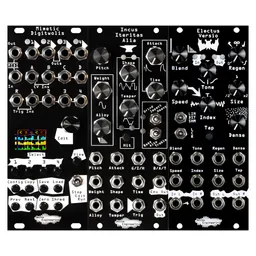We’ve already explored quite a few Eurorack utilities in this series, but some of the less common types are just as useful as their famous counterparts. Today, we’ll take a look at three types of utilities that aren’t as widely known, but are quite helpful in certain patching situations.
Comparators and window comparators
Comparators are a tool that create gate signals from incoming CV. The simplest comparator would have a CV input and a gate output, and the gate would go high as soon as the CV input is above a threshold, and goes low when the CV input is below that threshold again.

Most comparator modules add additional features, like offsets, multiple summed inputs, and adjustable thresholds.
Window comparators add even more to the concept: instead of having a single threshold, a window with minimum and maximum levels activates a gate output. This allows for more complex gate extraction and more flexibility in a patch.

Comparators aren’t a common type of module on their own, but they are often included as an extra feature on other modules, like envelope followers.
Minimum/maximum
Minimum and maximum, or analog logic functions, are an interesting way to combine multiple signals. These modules will generally have multiple inputs and a single output, but instead of mixing the inputs together, they will output only the highest signal in the case of analog OR, or the lowest signal in the case of analog AND.

Analog OR outputting the maximum of its input signals is particularly fun: as an example, it’s possible to create an ADSR curve out of an AD envelope and an ASR envelope by routing them through an OR.
Trigger delays
Trigger delays are a very straightforward utility that take in a trigger input, wait a fixed amount of time, then output the trigger. Most trigger delays have a fixed output pulse width, but a few, like our Jam Jam, take gate length into account when delaying the signal.
Trigger delays are fun for creative uses (like adding some off-the-grid feel to a patch), and are sometimes helpful for solving latency issues in long CV-processing chains.

Most audio-delay effects are AC coupled, meaning that they can’t process trigger or CV signals. A few DC-coupled delays exist that can be used on any type of signal, to interesting effect.
Suggested modules
Joranalogue Compare 2: A dual-channel window comparator and logic module.
Jam Jam: A trigger-processing utility, including an extensive trigger delay mode.







